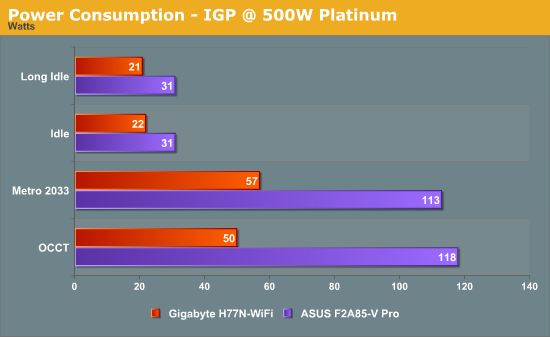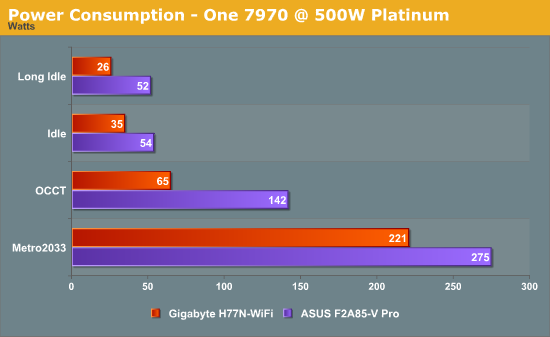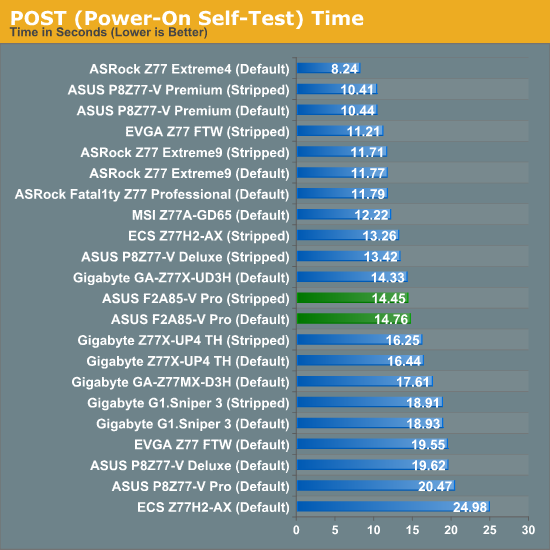ASUS F2A85-V Pro Review: A Look at FM2 with A85X
by Ian Cutress on October 10, 2012 11:20 AM EST- Posted in
- Motherboards
- Asus
- Trinity
- FM2
- A85X
Many thanks to...
We must thank the following companies for kindly donating hardware for our test bed:
OCZ for donating the Power Supply and USB testing SSD
Micron for donating our SATA testing SSD
G.Skill for donating our memory kits
ASUS for donating AMD GPUs and some IO testing kit
ECS for donating NVIDIA GPUs
Gigabyte for donating the i3-3225 used for comparison
Comparison of AMD Processors
On the following benchmarks, we will use results from comparible tests with previous processor families over the past 18 months. For AMD, this means we can compare the new Piledriver modules to Llano with its Stars cores, Phenom II and Thuban, and Zambezi with Bulldozer. The following processors are ones we have a variety of results for:
A6-3650 (32nm, 2.6 GHz) – Llano, 4 Stars cores
A8-3850 (32nm, 2.9 GHz) – Llano, 4 Stars cores
X6 1100T (45nm, 3.7 GHz Turbo) – Phenom II, 6 Thuban cores
FX-8150 (32nm, 4.2 GHz Turbo) – Zambezi, 4 Bulldozer modules
A10-5800K (32nm, 4.2GHz) – Trinity, 2 Piledriver modules
On the Intel side, we have the following:
Core i7-3960X (32nm, 3.9 GHz Turbo) – Sandy Bridge-E, 6 cores / 12 threads
Core i7-3770K (22nm, 3.9 GHz Turbo) – Ivy Bridge, 4 cores / 8 threads
Core i5-2500K (32nm, 3.7 GHz Turbo) – Sandy bridge, 4 cores / 4 threads
Core i3-3225 (22nm, 3.3 GHz) – Ivy Bridge, 2 cores / 4 threads
The aim of AMD is to put the A10 square on the bow of the Core i3-3225. For comparison, the A10-5800K release price is $122, whereas the boxed version of the i3-3225 should be ~$144.
Test Setup
| Processor |
AMD Trinity A10-4800K APU 2 Modules, 4 Threads, 3.8 GHz (4.2 GHz Turbo) |
| Motherboards | ASUS F2A85-V Pro |
| Cooling | beQuiet DarkPro CPU Cooler |
| Power Supply |
OCZ 1250W Gold ZX Series Rosewill SilentNight 500W Platinum PSU |
| Memory | G.Skill TridentX 4x4 GB DDR3-2400 10-12-12 Kit |
| Memory Settings | XMP |
| Video Cards |
ASUS HD7970 3GB ECS GTX 580 1536MB |
| Video Drivers |
Catalyst 12.3 NVIDIA Drivers 296.10 WHQL |
| Hard Drive | Corsair Force GT 60 GB (CSSD-F60GBGT-BK) |
| Optical Drive | LG GH22NS50 |
| Case | Open Test Bed - DimasTech V2.5 Easy |
| Operating System | Windows 7 64-bit |
| SATA Testing | Micron RealSSD C300 256GB |
| USB 2/3 Testing | OCZ Vertex 3 240GB with SATA->USB Adaptor |
Our main Intel comparison system is a to-be-reviewed Gigabyte H77N-WiFi with a 65W dual core i3-3225 processor against the 100W A10-5800K.
Power Consumption
Power consumption was tested on the system as a whole with a wall meter connected to a Rosewill 500W 80PLUS Platinum SilentNight power supply. As I am in the UK on a 230-240 V supply this leads to ~75% efficiency at low loads, and 90%+ efficiency between 20% and 100% loading. This method of power reading allows us to compare the power management of the UEFI and the board to supply components with power under load, and includes typical PSU losses due to efficiency. These are the real world values that consumers may expect from a typical system (minus the monitor) using this motherboard.


From our internal results, testing with 1 GPU on the 500W Platinum and 1250W Gold gave similar power readouts (Idle/OCCT/Metro on 500W gave 54/142/275, on 1250W gave 59/148/280), which means the 1250W is still good for comparison on the system. However for IGP testing, it was important to use the 500W. Our main comparison is the i3-3225 dual core Intel system on the to-be-reviewed Gigabyte H77N-WiFi, though the wattage between the processors accounts for large differences under load. At idle the larger ATX F2A85-V Pro does consume more power – if we get an ITX FM2 system, this will be a better comparison to test.
POST Time
Different motherboards have different POST sequences before an operating system is initialized. A lot of this is dependent on the board itself, and POST boot time is determined by the controllers on board (and the sequence of how those extras are organized). As part of our testing, we are now going to look at the POST Boot Time - this is the time from pressing the ON button on the computer to when Windows starts loading. (We discount Windows loading as it is highly variable given Windows specific features.) These results are subject to human error, so please allow +/- 1 second in these results.

The F2A85-V Pro uses ASUS’ new CAP BIOS system, designed to aid in POST times across their motherboard range. It helps a little here, as normally for ATX boards POST times are in the 16+ second region – the CAP BIOS reduces this to just under 15 seconds.










66 Comments
View All Comments
Mugur - Thursday, October 11, 2012 - link
File server - unchecked. Can't seem to find any board with 8 SATA, all are 7 + 1 eSATA... :-(Medallish - Thursday, October 11, 2012 - link
You make it sound A85X boards are somehow below average when it comes to number of ports, 7 ports is more than any Z77 or A75 based boards, if you have a fileserver that needs all 8 ports, then I'd suggest you buy a dedicated Sata controller for better performance anyway.Medallish - Thursday, October 11, 2012 - link
Also, Gigabyte boards with A85X doesn't have E-sata and therefore has all 8 Sata ports available.Mugur - Friday, October 12, 2012 - link
Gigabyte has 2 A85x boards. UP4 has 7 + 1. Only D3H has 8 and I haven't seen it in stock in my country... But this means there is hope.I have now an Asus with 850SB with 6 SATA 3 + PCIe card with 2 more. Unfortunately I haven't seen any mATX with 8 SATA so far.
hechacker1 - Thursday, October 11, 2012 - link
But it's so easy to get a cheap sata card without RAID support and just use software raid (freenas comes to mind).Why deal with buggy controllers anyway. Modern software raid is easily configurable and very fault tolerant, and you can even do things like SSD caching at the front end.
I do intend to build a NAS / server, and it's either Trinity or an i3.
Mugur - Friday, October 12, 2012 - link
I will try with Windows Server 2012 and Storage Spaces myself. I need Windows for my server at home. Hopefully it can make a logical drive with parity from different types of physical drives... or I got it all wrong. :-)cjs150 - Thursday, October 11, 2012 - link
HTPC - uncheckedTDP is way too high. That means significant active cooling, that means noise.
Do not mind having one slow fan in an HTPC but not more.
AMd need to have a sub 45W part on an FM2 board for it to be good for an HTPC. Do that at reasonable cost and AMD would clean up as nearest equivalent for intel is the i7-3770T which is expensive
Medallish - Thursday, October 11, 2012 - link
HTPC - RecheckedTDP is acceptable on both A10, 5700 and 5800 65W and even 100W can be cooled passively with the right HTPC case(Streacom FC5-OD). You can also buy a Jetway Mini ITX FS1r2 board that will work with A10-4600(35W TDP). If Mobile sockets is too exotic for you, it should take no time to adjust the A10 of any kind really, ,to run a 3GHz and get the tdp below 45W, but eally since when was 65W too much for one slow fan?
The Streacom case is btw. confirmed, I'm using it to cool down my current A8-3870k, works perfectly.
cjs150 - Thursday, October 11, 2012 - link
Streamcom FC5 specs are for a maximum of 65W TDP so 100W is outside of their envelope. 65W TDP will work fine, just as long as the room is not too warm. So I guess your A8-3870 is either under-clocked or currently in the fridge!!For an HTPC, it needs to play HD material smoothly, rip HD content quickly and I assume play some games at reasonable speed but nothing too taxing.
i7-3770T is way over-powered (and expensive) for that - and not as cool as it should be because intel use poor thermal paste on the IHS. AMD should therefore clean up this market. I prefer to have a CPU that is under the case thermal envelope to allow for margin for error.
So if it works for you (and I really like the Streamcom case) great, but for me AMD need to get a 22 nm part out with a much lower thermal envelope
butdoesitwork - Thursday, October 11, 2012 - link
1. Normally when a reviewer sees something anomalous he contacts the manufacturer prior to posting the review. Has there been any follow up with ASUS on the DPC latency spikes? Is a BIOS fix actually forthcoming? It's really hard to just leave it at "this would be slightly worrying for audio work"!2. The USB and SATA charts are nearly pointless. You're comparing a new AMD chipset against umpteen Intel motherboards. That's reasonable, but how does this new A85X chipset fare against older AMD 9xx chipsets? Is this new chipset an improvement? And if it isn't better, do they have an explanation why? And wouldn't that be another thing to ask ASUS about?
3. Speaking of older chipsets, why does the Sabretooth only make a cameo?
The X264 graphs are just silly! I thought we wanted a comparison between Thuban and Llano here, not just umpteen Core i7s! You did say "For AMD, this means we can compare the new Piledriver modules to Llano with its Stars cores, Phenom II and Thuban, and Zambezi with Bulldozer."
4. With all these gobbledygook-named motherboards floating around, it sure would be nice if the "gaming benchmarks" graphs also denoted which (admittedly also gobbledygook-named) CPU was paired with each one. Like the "computation benchmarks" did. It would simplify validating statements like "Portal 2 seems to enjoy the GPU power, and CPU power does not matter as much.".
5. On Dirt 3 "In the case of Trinity, the lack of grunt by the CPU does give it a lower result than the rest of our testing."
Be that as it may, where does it stand compared with the Core i3? Thuban? Llano?
Trinity isn't even meant to (and certainly can't) compete with Core i7, so why are these graphs so dominated by them? I wouldn't expect radical fluctuations between the Intel chipset boards. Are you looking for motherboard-influenced performance quirks? If so, shouldn't you also be comparing multiple A85X motherboards?
6. Above ALL else, this is a new chipset. Accordingly, have you done any stability and reliability testing? Speed is nice, but what good is it if the new fangled SATA3 and USB3 ports exhibit device compatibility issues or data corruption? (Have you done a "diff" of your files in Linux? Or noted any bus reset errors in Linux logfiles? You know...the kinds of things Windows never tells you?)